WORLD CLASS COACHING
Club Curriculum Fun Training Games
By Tony Englund
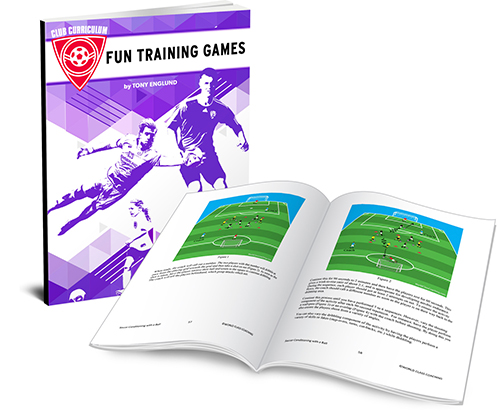
TABLE OF CONTENTS
Part Four
PASSING & BALL STRIKING GAMES
ABOUT THE AUTHOR
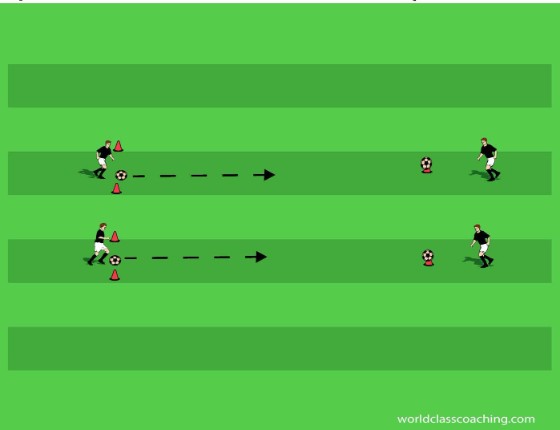
Pineapple Drop - 10x15 yard areas
Divide the group into teams of 3-4. One player puts her ball atop the group’s cone and then steps behind to monitor and retrieve errant shots. The other players form a line and proceed to pass/strike their balls (one at a time) in an effort to knock the ‘pineapple’ off of the cone. When a successful shot is made, the shooter puts her ball atop the cone and becomes the monitor. Play for two minutes and check scores.
Variations
• Players must use their off foot to strike the ball.
• Vary the length of the shot area.
• Players must hit a moving ball.
Pac man - 20x20 yard grid
Two players are “Pac men” to start. All players have a ball and the Pac men wear distinctive vests. In this game, players dribble their balls around the grid and the Pac men try to kick their own soccer balls to hit the balls of the dribbling players. If their ball is struck, the players then put on a vest and join the Pac team until all players have been caught. It is critical to emphasize safety here. All balls must remain on the ground throughout the exercise.

Keep your yard clean - (2) 20x20 yard grids
Each player needs a ball. Put half the team in each grid. This is a simple exercise designed to give players the opportunity to practice striking the ball. The goal of the exercise is to keep as many balls as possible in the other team’s “yard.” Require players to stop the ball before striking it. Play for one minute and check the number of balls in each grid before restarting play. The coach should emphasize using the inside of the foot or the laces to strike the ball and also locking the foot. The nice part of this exercise is that accuracy is not particularly important, so players can just focus on striking the ball.
Variations
• Adjust the size of the center area to increase the challenge or success rate.
• All shots must be taken with the ‘off’ foot.
Passing Relay - 15X30 yard area
Divide the group into two teams and spread them out in two lines, with 5-10 yards (depending on age and ability) between each player. Each team gets a ball to start at one end of their line. The object of the game is to pass the ball along the team’s line to the far end as quickly as possible. Each player must stop the ball and pass it in turn. When both teams have worked the ball to the other end of their lines, determine a winner and then play again in the other direction.
Variations
• Each player must take four dribbling touches (in place) before passing to the next player.
• Play with the off foot only.
• Demonstrate the importance of turning one’s hips and shoulders after receiving to face the next player in line before passing the ball. Encourage players to control the ball and then turn before passing.
Windows - 20x20 yard area
One-half of the group, each with soccer balls, spread around the perimeter of the grid. The other half of the group, without soccer balls, are inside the area. At the signal from the coach, the active players on the inside run toward a player on the outside, stopping 3-5 yards away (demonstrate the proper spacing). Then the player on the outside passes to the inside player, who stops the ball with the base of her shoe and then passes it back. Then the inside player finds another player with whom to exchange passes. Play for one minute and then change roles. Who can get the most exchanges?
Variations
• Control the ball with the inside of the foot.
• 1-touch passing.
• Start the balls on the inside. The active players pass to a player on the outside, receive a pass back, and then dribble to another target player.
• Start the balls on the inside. The active players pass the ball to a player on the outside and then take that player’s place. The receiving player on the outside dribbles into the grid and looks for another outside player to pass to.
Soccer Golf - Field Area
Each player has a ball. This is a fun way to work on striking the ball and also passing accuracy. The coach selects a target and the players see how many strikes they need to get their ball to hit the target. It’s fun to utilize non-traditional targets, such as waste receptacles, fence posts, large trees (go easy on nature here), and also to compel the players to play across baseball infields, up or down hill, around trees, etc.
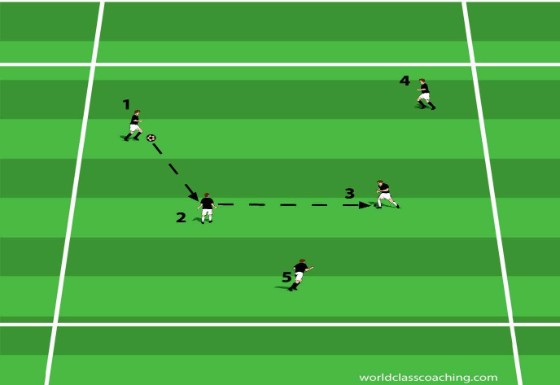
Sequenced Passing - 20x20 yard grid
Give each player a number (U8+). Use one ball. Player #1 dribbles the ball until player #2 approaches and then she passes the ball to her. Player #2 finds player #3 and play continues. The highest number plays to #1. Emphasize movement and communication. To add some fun, count to see how many passes can be completed in one minute and then see if the team can beat that score in the second minute.
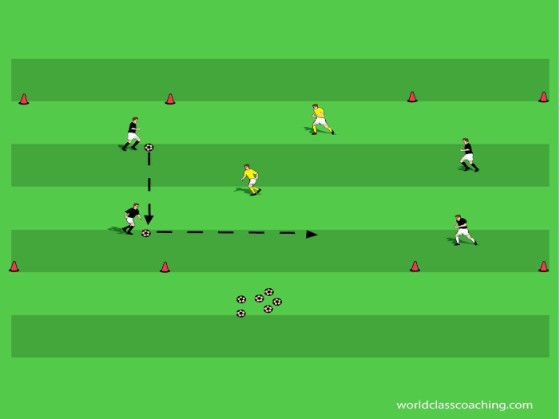
Monkeys - (3) 17x10 yard grids
Divide the group into three teams and put one team in each section. The end teams pass the ball back and forth and the middle team attempts to win the ball. When the middle team gains control of the ball, the team they won it from takes their place in the middle. Encourage the teams in the end grids to dribble and pass the ball within their grids to create an angle from which they can safely pass the ball to the other grid. If one team gets stranded in the middle for more than a minute, rotate them out so that everyone gets to work on playing through occupied space to a target.
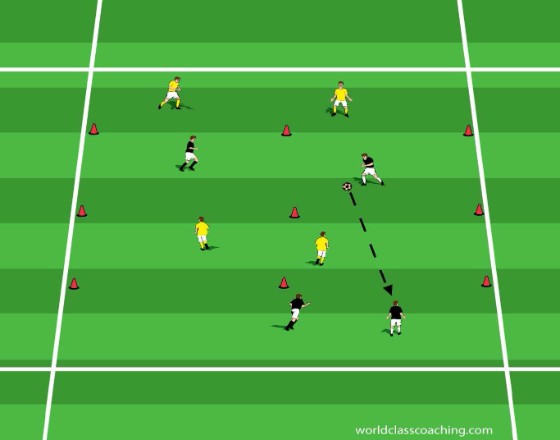
4-zone passing - (4) 12x6 yard grids
(U8+)Divide the group into two teams and place ½ of each team in two grids (one end grid and the middle grid on the opposite side –see diagram). The other team occupies the remaining two grids. Explain that the purpose of the game is work on passing to teammates in the other grid. All players must stay in the grid where they start the game. The team not in possession attempts to intercept passes and then play to their teammates in the other grid. Encourage players to pass within their grid to create a passing angle to the other grid. Give one point for each successful pass across the opponent’s grid.
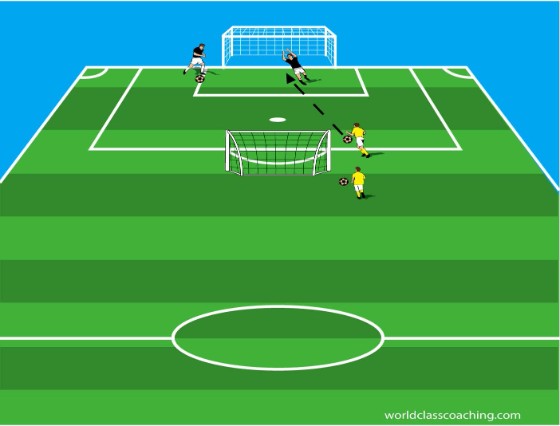
Shoot-keep-retrieve
Divide the team into two groups. Put each group at the side (opposite sides – see diagram) of a goal. Players take turns shooting the ball at the other goal, then playing goalkeeper for one turn and then getting a ball and getting back in line. Players may not cross the center line between the goals before shooting. Adjust the grid size to be sure that players are not too close (for safety reasons) or too far away (shots are not reaching the goals). For U8 players, the goals should be about 10 yards apart and 3 yards in width. Encourage players to shoot on the ground and to use their laces or the inside of their foot to strike the ball.
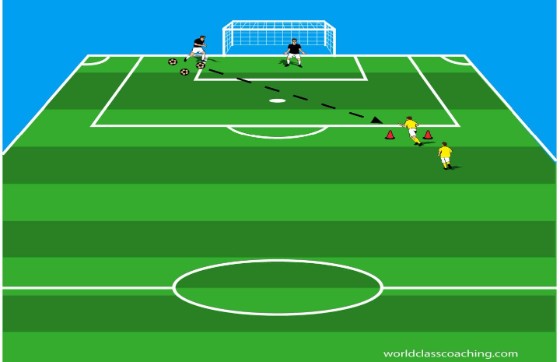
1v1 to Goal - ½ field
Divide the team into two groups. One group, with soccer balls, lines up next to one of the goal posts. The other group lines up at the top of the large box. The first player in the line by the goal passes the ball to the first player in the other line and then plays defense. The receiving player attempts to beat the defender and score. If the defender wins the ball, she tries to dribble the ball out of the large box. Players change lines and the next duel begins.
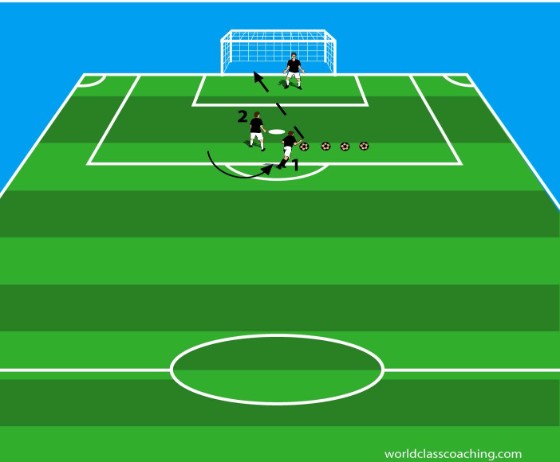
Speedy Shooting
The active player here (1) runs around the resting player (2) and shoots to score past the goalkeeper (3). After each shot, the active player must run around the resting player before shooting again. Play until the ball supply is exhausted, and then rotate roles and play again. See which player can score the most goals. For U6 teams, play without a goalkeeper.
Money in the bank - 1/3 field
Spread balls around the 1/3 of a field in front of a goal, but outside the large box. Appoint a pair of ‘bandits’ to play in front of goal. The bandits try to block ‘deposits’ by the rest of the team, who try to put balls into the goal through dribbling and shooting. Any ball won by the bandits is passed back outside the box area and the person trying to make a deposit just starts over. Play until all of the ‘money’ is deposited, then change bandits.
Big goals! – Area Varies
Play a regular game, but with very large goals (i.e. U11-U12 or even U13+ goals). Encourage players to shoot early and often. This type of setting promotes both fun and successful attacking.
Variations
• Play to end lines, but allow shooting (the entire line is the goal).
• Play to as many goals as you can create (cones, flags, etc.).
Portable goal - ½ field
Two players or coaches hold onto the ends of a rolled-up towel and walk or run around the field, creating a portable goal. All other players have a ball and dribble around the area, scoring by passing the ball through the moving goal. Play for two minutes and then rotate the ‘posts.’ Who can score the most goals?
Variations
• Players can only shoot with their off foot.
• Players must dribble over a field line after scoring before shooting again.
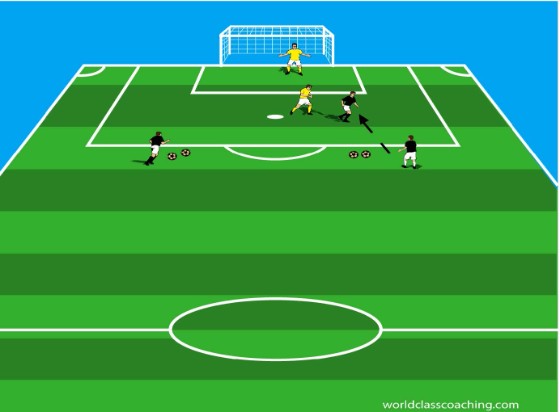
1v1 Hotbox to goallarge goal box
Place two players (plus a goalkeeper for U8) inside the box. BothPlayers are trying to score at all times (while preventing their opponent from scoring). The remaining players act as servers and line up with balls around the edge of the area. The coach indicates which server should introduce a new ball each time the ball leaves the area. Play for two minutes and then rotate the middle pair.
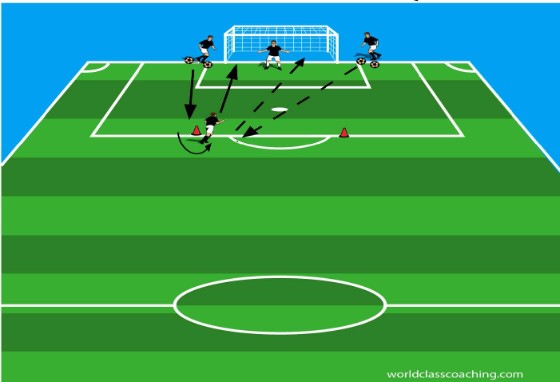
Pass/Shoot/Play GK - goal box area
Create two even teams and have them collect balls just outside the posts. One player starts in goal. A player from the other team runs around the cone 10 yards from goal and then receives a pass from the opposing line. The attacking player takes a touch to set the ball and then takes a shot at goal. The shooter then plays goalkeeper for one turn and the passer becomes the attacker. Urge players to remember to move to their next role quickly and to restore the ball supply after playing goalkeeper. Keep track of goals scored for each team.
Variations
• One-touch shooting
• Give points for great saves
• Rebounds are live
• Only goals scored in the air count
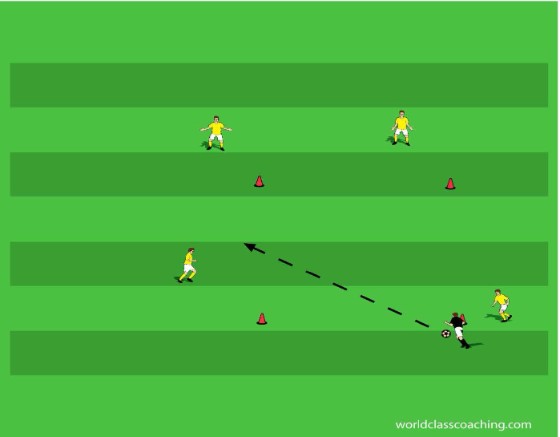
Soccer kickball - ½ field
Divide the group into two teams. The game is played similarly to kickball, with the batter kicking the ball and then trying to touch all 3 bases and return to home plate. The fielding team must run down the ball and return it to the home plate cone before the runner gets there. Each team bats around and then rotates to the field.
Variations
• The fielding team, to create an out, must run down the ball and then pass it amongst themselves until all team members have touched the ball before the runner returns home.
• Batters must use their ‘off’ foot.
Sources and Recommended Reading
Alagich, Richard. Soccer: Winning Through Technique and Tactics. New York, NY: McGraw-Hill, 1996.
Fairclough, Paul. Soccer Strategies. Buffalo, NY: Firefly Books, 2009.
Fleck, Tom, and Ron Quinn. The Baffled Parents’ Guide to Great Soccer Drills. Camden, ME: Ragged Mountain Press, 2002.
Galustian, Alf and Charlie Cooke. A New Era: A Coerver Coaching Masterclass Series. Sportsmethod, 1998.
Green, Shaun. Soccer Made Easy: Coaching 9-12 Year Olds. Spring City, PA: Reedswain, 2002.
Gregg, Lauren. The Champion Within: Training for Excellence. Burlington, NC: JTC Sports, 1999.
Harrison, Wayne. Full Season Training Program: A Complete Season of Training Sessions for a Competitive U12 Team. Leawood, KS: World Class Coaching, 2007.
Kormelink, Henny and Tjeu Seeverens. Developing Players the Dutch Way. Spring City, PA: Reedswain, 1996.
NSCAA. State Diploma. Course materials.
NSCAA. Regional Diploma. Course materials.
NSCAA. Advanced Regional Diploma. Course materials.
NSCAA. Coaching Soccer. Edited by Tim Schum. Indianapolis, IN: Masters Press, 1996.
Rees, Roy. The Manual of Soccer Coaching. Spring City, PA: Reedswain, 1995.
Rees, Roy and Cor Van Der Meer. Coaching Soccer Successfully. Champaign, IL: Human Kinetics, 1997.
Success in Soccer (DFB). Basic Training:Techniques and Tactics for Developing the Serious Player. Munster, Germany: Philippka Sportverlag, 2002.
Success in Soccer (DFB). Modern Youth Training: The Complete Guide to Soccer for Kids. Munster, Germany: Philippka Sportverlag, 2006.
Stoop, Tino. Coaching Under 10’s: A Complete Coaching Course. Spring City, PA: Reedswain, 2003.
United States Soccer Federation. Soccer: How to Play the Game: The Official Playing and Coaching Manual of the United States Soccer Federation. New York, NY: Universe Publishing, 1999.
Wein, Horst. Developing Game Intelligence. Spring City, PA: Reedswain, 2004.
Wilkinson, Roger, and Mick Critchell. 300 Innovative Soccer Drills for Total Player Development. Spring City, PA: Reedswain, 2000.
About the Author
Tony Englund is the Assistant Director of Coaching at St. Croix Soccer Club. Tony has earned more than a dozen diplomas from the National Soccer Coaches’ Association of America, including the Premier, National Goalkeeping and Director of Coaching awards and he serves as an Associate Staff Coach for that organization. Tony is a frequent presenter at high-level coaching clinics. He has served as Director of Coaching and Player Development with three Minnesota clubs and has more than twenty years’ experience as a successful club, high school and college head coach. His teams have repeatedly earned promotion to the highest levels of state and Midwest Regional League play and won multiple state championships, premier league titles and consistent regional rankings. He is the author of nine books published by WORLD CLASS COACHING.


